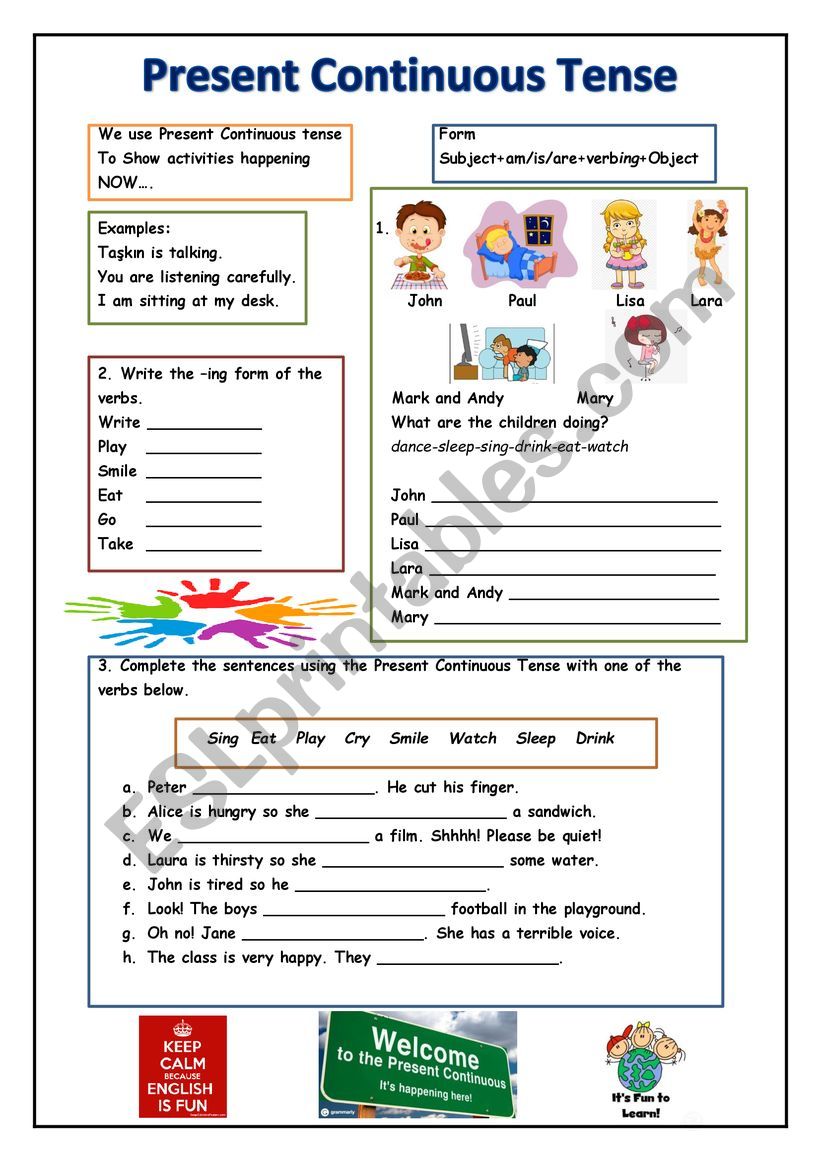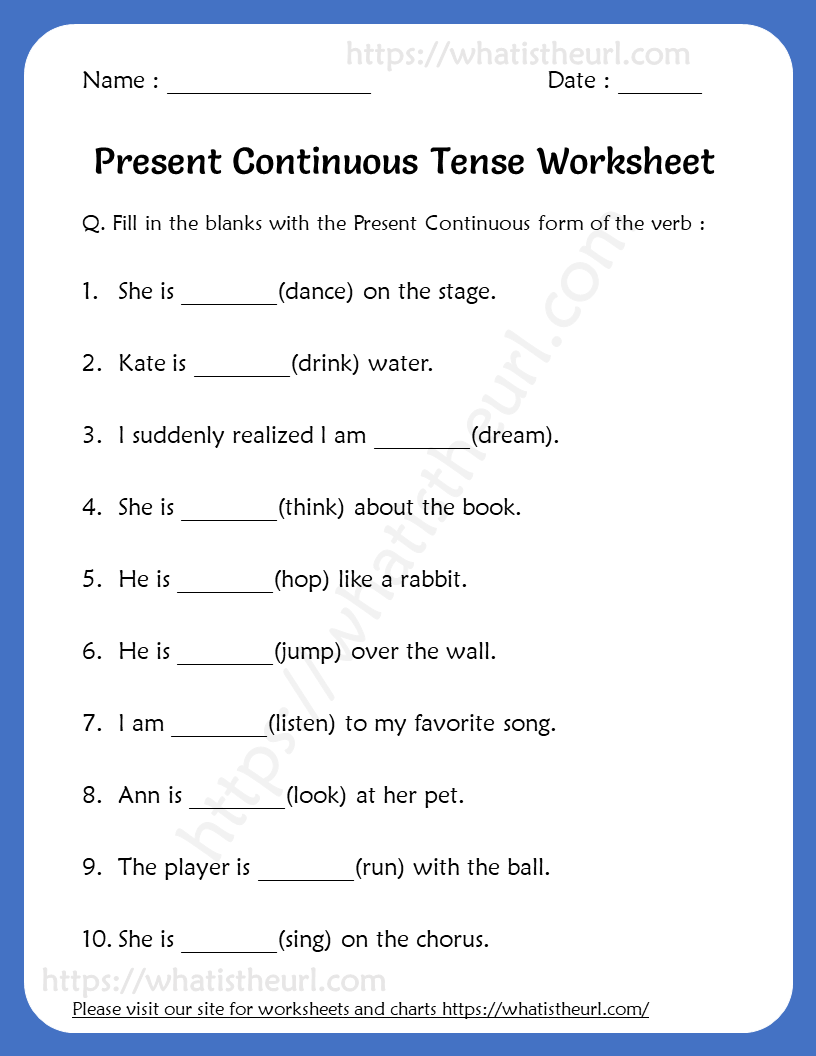
Mastering the Flow of Now: The Essential Role of Grammar Worksheets: Present Continuous Tense
In the intricate tapestry of language learning, grammar serves as the foundational warp and weft, providing structure and meaning to our communication. Among the various tenses, the Present Continuous T Tense holds a unique and dynamic position, capturing actions as they unfold, temporary situations, and even future plans. For learners, grasping its nuances can be challenging, but with the right tools, mastery is well within reach. This is where Grammar Worksheets: Present Continuous Tense emerge as indispensable allies, offering structured practice, reinforcement, and a clear path to fluency.
This article will delve into the profound importance of the Present Continuous Tense, explore the multifaceted benefits of utilizing Grammar Worksheets: Present Continuous Tense, discuss effective design principles for these valuable resources, and provide strategies for their optimal implementation in both classroom and self-study environments.
Understanding the Present Continuous Tense: The Rhythm of the Moment

Before we delve into the worksheets, let’s firmly establish our understanding of the Present Continuous Tense itself. Often referred to as the Present Progressive, this tense describes actions that are happening at the very moment of speaking, or around that time. It conveys a sense of ongoing activity, dynamism, and immediacy.

Form:

The Present Continuous Tense is formed using the present tense of the verb "to be" (am, is, are) followed by the base form of the verb with an "-ing" suffix (the present participle).

- Affirmative: Subject + am/is/are + Verb-ing
- Examples: I am reading a book. She is cooking dinner. They are playing football.
- Negative: Subject + am/is/are + not + Verb-ing

- Examples: I am not sleeping. He isn’t working today. We aren’t watching TV.

- Interrogative: Am/Is/Are + Subject + Verb-ing?

- Examples: Are you listening? Is he coming to the party? Am I making sense?


Key Uses:
- Actions Happening Now: This is the most common use.
- Example: The children are laughing loudly right now.
- Temporary Actions/Situations: Actions that are ongoing but not permanent.
- Example: He is living in London for a few months. (He usually lives elsewhere).
- Annoying Habits (with ‘always,’ ‘constantly,’ ‘forever’): Used to express irritation or criticism.
- Example: She is always complaining about something!
- Future Arrangements (with a time expression): When an action is planned and confirmed for the near future.
- Example: We are meeting Sarah tomorrow evening.
Understanding these forms and uses is the first step. The next, and perhaps most crucial, step is consistent practice, which is where Grammar Worksheets: Present Continuous Tense become invaluable.
The Indispensable Role of Worksheets in Grammar Acquisition
Why are worksheets, particularly for a dynamic tense like the Present Continuous, so critical? They offer a structured, systematic, and often self-paced approach to language learning that complements other teaching methodologies.
- Reinforcement and Practice: Language learning is not just about understanding rules; it’s about internalizing them through repeated application. Worksheets provide the necessary repetition to solidify new grammatical concepts.
- Active Learning: Unlike passive listening or reading, completing a worksheet requires active engagement. Learners must recall rules, apply them, and construct correct sentences.
- Identification of Weaknesses: When learners make mistakes on a worksheet, it immediately highlights areas where their understanding is shaky. This allows educators (or self-learners) to target specific difficulties.
- Structured Progression: Well-designed worksheets can guide learners through increasing levels of complexity, starting with basic form recognition and moving to contextual application.
- Self-Assessment and Feedback: Many worksheets come with answer keys, allowing learners to check their own work and receive immediate feedback, fostering independent learning and confidence.
- Catering to Different Learning Styles: While some learners thrive in communicative activities, others benefit from the quiet, focused environment that worksheets provide, allowing them to process information at their own pace.
- Record of Progress: Completed worksheets serve as a tangible record of a learner’s progress over time, offering a sense of accomplishment and motivation.
In essence, Grammar Worksheets: Present Continuous Tense bridge the gap between theoretical knowledge and practical application, transforming abstract rules into usable language.
Designing Effective Grammar Worksheets: Present Continuous Tense
Not all worksheets are created equal. An effective worksheet for the Present Continuous Tense should be engaging, comprehensive, and pedagogically sound. Here are key considerations for their design:
-
Variety of Exercise Types: Monotony is the enemy of learning. A good worksheet should incorporate diverse exercise formats:
- Fill-in-the-Blanks: (e.g., "She _____ (read) a novel now.")
- Sentence Completion: (e.g., "The birds are singing, so…")
- Error Correction: (e.g., "He is work at the moment." -> "He is working at the moment.")
- Sentence Transformation: (e.g., "They play tennis." -> "They are playing tennis now.")
- Reordering Scrambled Words: (e.g., "eating / is / my / dinner / brother.")
- Picture Description: Learners describe what people/things are doing in an image.
- Short Answer Questions: (e.g., "What are you doing right now?")
- Dialogue Completion: Filling in missing parts of a conversation using the Present Continuous.
- Creative Writing Prompts: Asking learners to write a short paragraph describing a busy scene (e.g., a park, a market).
-
Gradual Increase in Difficulty: Start with simple affirmative sentences, then introduce negatives, interrogatives, and finally, contextual applications and distinctions from other tenses (especially the Simple Present).
-
Clear and Concise Instructions: Ambiguous instructions can frustrate learners. Use simple language and provide examples for each exercise type.
-
Relevant and Engaging Content: Use topics that resonate with learners’ interests and everyday experiences (e.g., daily routines, hobbies, current events, family life). Humor or relatable scenarios can significantly boost engagement.
-
Inclusion of an Answer Key: For self-study or quick checking in class, an answer key is essential for immediate feedback.
-
Visual Appeal: For younger learners, or even adults, incorporating relevant images, clear layouts, and appropriate fonts can make the worksheets more inviting and less intimidating.
-
Focus on Context: While mechanical drills are useful, ensure there are exercises that require learners to understand the meaning and context of the Present Continuous, not just its form. This includes exercises differentiating it from the Simple Present.
Types of Exercises for Present Continuous Worksheets (A Deeper Dive)
Let’s break down specific exercise types that are particularly effective for teaching the Present Continuous:
- Basic Affirmative Construction: Simple sentences where learners just add ‘am/is/are’ and ‘-ing’.
- Example: John _____ (watch) TV. -> John is watching TV.
- Negative Form Practice: Exercises focusing on the ‘not’ placement.
- Example: We _____ (not / go) to the beach today. -> We are not going to the beach today.
- Interrogative Form Practice (Yes/No Questions):
- Example: you (listen) to music? -> Are you listening to music?
- Wh-Question Formation: Learners form questions based on given answers.
- Example: Answer: "I am reading a book." Question: "What you (do)?" -> "What are you doing?"
- Short Answers: Matching questions with appropriate short answers (Yes, I am. / No, she isn’t.).
- Distinguishing Present Continuous from Simple Present: This is a crucial area. Worksheets should include mixed exercises where learners have to decide which tense to use based on time expressions (now, at the moment vs. usually, every day) and context.
- Example: He usually plays tennis, but today he is playing basketball.
- Contextual Paragraph Completion: Learners fill in verbs in a short story or description where the context clearly indicates the Present Continuous.
- "What’s Happening in the Picture?": Providing an image and asking learners to write sentences describing the actions taking place. This encourages observation and direct application.
By incorporating a rich array of these exercise types, Grammar Worksheets: Present Continuous Tense can provide comprehensive and varied practice.
Implementing Worksheets in the Classroom and for Self-Study
The mere existence of worksheets isn’t enough; their effective implementation is key to maximizing their benefits.
In the Classroom:
- Pre-Lesson Diagnostic: Use a short worksheet to gauge students’ prior knowledge before introducing the tense.
- Guided Practice: After explaining the rules, work through the first few exercises together as a class, clarifying doubts.
- Independent Practice: Allow students to complete sections independently, circulating to offer help.
- Pair/Group Work: Encourage students to complete worksheets in pairs or small groups, fostering peer learning and discussion.
- Feedback and Correction: Go over answers as a class. Don’t just provide the correct answer; explain why it’s correct. Encourage students to correct their own mistakes.
- Homework: Assign worksheets as homework to reinforce learning outside the classroom.
- Differentiation: Provide simpler versions for struggling learners and more challenging ones (e.g., creative writing prompts, complex error correction) for advanced students.
For Self-Study:
- Understand the Rules First: Before attempting a worksheet, ensure you have a solid grasp of the Present Continuous forms and uses. Use a grammar book or online resources.
- Work Systematically: Don’t jump around. Start with simpler exercises and progress to more complex ones.
- Don’t Rush: Take your time to understand each question and formulate your answer carefully.
- Use the Answer Key Wisely: Try to complete an entire section before checking your answers. If you make a mistake, try to understand why you made it before looking at the correct answer.
- Identify Patterns of Error: If you consistently make the same type of mistake, note it down and focus extra attention on that specific rule or form.
- Integrate with Other Skills: After completing a worksheet, try to use the Present Continuous in speaking or writing tasks.
Beyond the Worksheet: Integrating for Holistic Learning
While Grammar Worksheets: Present Continuous Tense are fundamental, they are most effective when integrated into a broader language learning ecosystem.
- Speaking Practice: After completing a worksheet, engage in role-plays (e.g., describing what people are doing in a busy scene), interviews ("What are you wearing? What are you reading?"), or simply asking each other "What are you doing?" throughout the day.
- Writing Tasks: Encourage learners to write short descriptions (e.g., of their family members’ activities at a specific time), diary entries, or emails where the Present Continuous naturally fits.
- Listening Activities: Use songs, short video clips, or dialogues where the Present Continuous is frequently used. Ask learners to identify and note down sentences using the tense.
- Games: Create interactive games like charades (acting out actions and guessing "What is he doing?"), Pictionary, or board games that require the use of the tense.
- Real-World Application: Encourage learners to pay attention to the Present Continuous in everyday English, whether it’s in news headlines, social media posts, or conversations.
By combining the structured practice offered by Grammar Worksheets: Present Continuous Tense with dynamic communicative activities, learners gain a more holistic and robust understanding, enabling them to use the tense naturally and confidently in real-world situations.
Conclusion
The Present Continuous Tense is a vital component of English grammar, allowing speakers to convey immediacy, temporary actions, and future plans with precision. For both educators seeking to provide effective instruction and learners striving for mastery, Grammar Worksheets: Present Continuous Tense stand out as indispensable tools.
They provide the necessary structure for repetitive practice, facilitate self-assessment, highlight areas for improvement, and cater to diverse learning styles. From basic sentence formation to nuanced contextual application and differentiation from other tenses, well-designed worksheets guide learners through a systematic path to proficiency. When strategically implemented and integrated with communicative activities, these worksheets transcend mere drills, becoming powerful catalysts for genuine language acquisition.
In the journey of language learning, every step counts. And with the consistent and thoughtful use of Grammar Worksheets: Present Continuous Tense, learners can confidently grasp the rhythm of the moment and express themselves with the dynamic flow of now.
